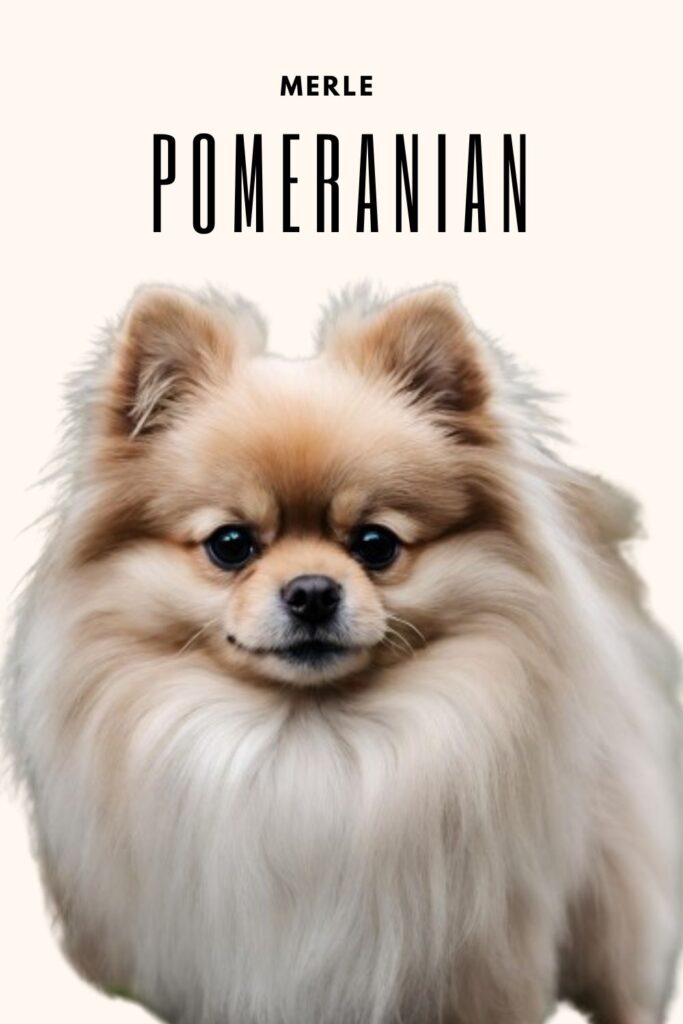Introduction
Embark on a journey through the vibrant history of Merle Pomeranian dogs, a fascinating and visually stunning breed with a rich heritage. In this exploration, we’ll delve into the definition of Merle Pomeranians, uncover interesting facts, and understand the complexities of their colors, breeding practices, genetics, and potential health considerations.
What is a Merle Pomeranian?
A Merle Pomeranian is a type of Pomeranian that displays a specific coat color pattern known as merle. Merle is a genetic trait characterized by patches or splotches of color on a lighter base coat, often with a mottled or marbled appearance. The patches can vary in size and distribution across the dog’s body.
Merle Pomeranians typically have a base coat color of orange, sable, cream, or white, with the merle pattern overlaying it. The merle pattern can come in various colors, including blue, red, chocolate, or black, creating a striking and unique appearance.
It’s important to note that while merle Pomeranians are visually striking, the merle gene can be associated with certain health concerns, particularly when two merle genes are present (known as double merle). Double merle can lead to a higher risk of hearing and vision impairments, as well as other health issues, so responsible breeding practices and health testing are crucial when breeding merle Pomeranians.
Merle Pomeranians, like all Pomeranians, require regular grooming, exercise, and proper care to maintain their health and well-being.
Merle Pomeranian Dog Facts
Here are some facts about Merle Pomeranian dogs:
- Coat Color and Pattern: Merle Pomeranians have a distinctive coat color pattern characterized by patches or splotches of color on a lighter base coat. The merle pattern creates a marbled or mottled appearance, and the patches can vary in size and distribution across the dog’s body.
- Genetics: The merle coat pattern in Pomeranians is inherited through genetics. It is caused by a dominant gene that affects the distribution of pigment in the dog’s coat. However, breeding two merle Pomeranians together can result in health issues associated with double merle genetics, including hearing and vision impairments.
- Health Considerations: While merle Pomeranians are visually striking, responsible breeding practices are essential to minimize the risk of genetic health issues associated with the merle gene. Health testing and screening for potential hereditary conditions are crucial for breeding merle Pomeranians responsibly.
- Personality: Merle Pomeranians share the same personality traits as other Pomeranians. They are often described as lively, intelligent, affectionate, and outgoing. They enjoy being around people and thrive on attention and companionship.
- Grooming: Like all Pomeranians, Merle Pomeranians require regular grooming to keep their coat healthy and free of mats and tangles. Brushing a few times a week, along with occasional baths, can help maintain their coat’s appearance and overall hygiene.
- Exercise Needs: Merle Pomeranians have moderate exercise needs. Daily walks, playtime, and interactive toys can help keep them mentally stimulated and physically active. Despite their small size, they enjoy exploring and participating in various activities.
- Lifespan: Merle Pomeranians, like other Pomeranians, have an average lifespan of 12 to 16 years. Providing proper care, nutrition, and regular veterinary check-ups can help ensure a long and healthy life for your Merle Pomeranian.
- Companionship: Merle Pomeranians make excellent companions for individuals and families alike. They are loyal and devoted to their owners and enjoy spending time with their human family members. Proper training and socialization from an early age can help shape their behavior and ensure they are well-adjusted pets.
Everything About the Blue Merle Pomeranian Dog
The Blue Merle Pomeranian is a variation of the Pomeranian breed characterized by its striking coat color and pattern. Here’s everything you need to know about the Blue Merle Pomeranian:
Coat Color and Pattern:
- The Blue Merle Pomeranian has a predominantly grayish-blue coat with patches or marbling of black, gray, and sometimes tan or white.
- The Merle gene is responsible for the unique coat pattern. It causes patches of diluted pigment on a lighter base coat, creating the Merle effect.
- The intensity of the blue and the distribution of the merle pattern can vary widely among Blue Merle Pomeranians.
Appearance:
- In addition to their distinct coat color, Blue Merle Pomeranians typically exhibit all the physical characteristics of the Pomeranian breed. They are small, compact dogs with a fox-like face, erect ears, and a plumed tail that curls over their back.
- Their eyes can vary in color, including blue, brown, or a combination of both, which adds to their unique and captivating appearance.
Temperament:
- Blue Merle Pomeranians share the typical Pomeranian temperament. They are lively, intelligent, and affectionate dogs known for their bold and outgoing personalities.
- They enjoy being the center of attention and thrive on companionship and interaction with their human family members.
Health Considerations:
- While Blue Merle Pomeranians are generally healthy dogs, they may be prone to some health issues associated with the merle gene, such as deafness, vision problems, and skin sensitivities.
- Responsible breeding practices, including health testing and screening for potential genetic issues, can help minimize the risk of health problems in Blue Merle Pomeranians.
Care and Maintenance:
- Blue Merle Pomeranians require regular grooming to keep their coat clean and free of mats and tangles. Brushing a few times a week and occasional baths with a gentle shampoo are typically sufficient.
- They have moderate exercise needs and enjoy daily walks, playtime, and interactive toys to keep them mentally and physically stimulated.
Companionship:
- Blue Merle Pomeranians make wonderful companions for individuals and families who appreciate their affectionate nature and lively demeanor.
- Early socialization and training are essential to ensure they develop into well-behaved and well-adjusted pets.
In summary, the Blue Merle Pomeranian is a captivating and charming breed known for its unique coat color and friendly personality. With proper care, training, and attention to their health needs, they can make loving and devoted companions for many years.
Merle Pomeranian Price Information
How Much is a Blue Merle Pomeranian?
The price of a Merle Pomeranian can vary significantly depending on factors such as the dog’s lineage, pedigree, coat quality, breeder reputation, and geographical location. On average, Merle Pomeranians from reputable breeders can range from $1,000 to $3,000 or more, with certain factors like coat color, markings, and bloodline influencing the price. Rare or show-quality Merle Pomeranians with desirable traits may command higher prices, sometimes exceeding $5,000 or even $10,000. It’s crucial for prospective buyers to do thorough research, ensure the legitimacy of the breeder, and prioritize the health and well-being of the dog over price considerations. Additionally, adoption or rescue may be more affordable options for those seeking a Merle Pomeranian companion.
History of the Merle Pomeranian Dog
The Merle Pomeranian, like other varieties of Pomeranians, traces its ancestry to the Pomerania region, which is now part of Germany and Poland. Originally, Pomeranians were larger working dogs used for tasks such as herding and guarding. Over time, selective breeding aimed to reduce their size while enhancing their appearance and temperament.
The Merle coat pattern in Pomeranians likely originated from genetic mutations that produced the characteristic diluted patches of color on a lighter base coat. While the exact history of the Merle Pomeranian is not extensively documented, the Merle gene is known to exist in various dog breeds and likely emerged through natural genetic variation.
Merle Pomeranians gained popularity as companion animals, especially during the 19th century when Queen Victoria of England became fond of the breed. Her interest in Pomeranians helped popularize them among the elite and contributed to their recognition as beloved pets.
Today, Merle Pomeranians are cherished for their striking appearance and affectionate nature. While they may be more prone to certain health issues associated with the Merle gene, responsible breeding practices and proper care can help ensure their well-being.
Merle Pomeranian Colors
Merle Pomeranians come in a variety of colors and patterns due to the unique Merle gene. The Merle gene dilutes the base coat color and produces patches or spots of darker color throughout the coat. Here are some common Merle Pomeranian colors:
- Blue Merle: Blue Merle Pomeranians have a predominantly grayish-blue coat with patches or marbling of black, gray, and sometimes tan or white.
- Red Merle: Red Merle Pomeranians feature a red or copper base coat with patches or speckles of darker red, brown, or black throughout the fur.
- Chocolate Merle: Chocolate Merle Pomeranians have a chocolate or brown base coat with darker chocolate or black patches or spots.
- Black Merle: Black Merle Pomeranians have a black base coat with patches or marbling of lighter black, gray, or white.
- Sable Merle: Sable Merle Pomeranians have a sable or tan base coat with patches or streaks of darker colors such as black or brown.
These are just a few examples of the Merle Pomeranian colors that can occur. The Merle gene can produce a wide range of unique and visually striking coat patterns, making each Merle Pomeranian truly unique and beautiful in its own way.
Breeding Merle Pomeranians
Delve into the responsible breeding practices for Merle Pomeranians, emphasizing ethical considerations, genetic diversity, and the well-being of the dogs.
Genetics of the Merle Pomeranian
Explore the genetics behind Merle Pomeranians, unraveling the complexities of the Merle gene and how it influences coat patterns and colors.
Breeding Merle to Merle Pomeranians
Understand the potential challenges and ethical considerations associated with breeding Merle Pomeranians to maintain the breed’s health and vitality.
Health Problems Associated With the Merle Gene
Merle Puppy Pomeranian Health Issues:
Examine potential health issues associated with Merle Pomeranians, focusing on deafness, eye defects, sterility, and how responsible breeding practices can mitigate these concerns.
Deafness
Learn about the correlation between the Merle gene and deafness in Pomeranians, understanding how breeders can work to minimize this risk.
Eye Defects
Explore the potential eye defects that Merle Pomeranians may face and how regular veterinary check-ups can help in early detection and management.
Sterility
Understand the considerations regarding sterility in Merle Pomeranians and how responsible breeding practices aim to safeguard the health of the breed.
Final Thoughts on Merle Pomeranian Puppies
Wrap up the exploration of Merle Pomeranian dogs with insightful reflections, considerations for potential owners, and an invitation to appreciate the beauty and uniqueness of these captivating companions.




Pingback: Pomeranian Prices in 2024: Discover 10 SHOCKING Factors that Influence the Price - barksage.com